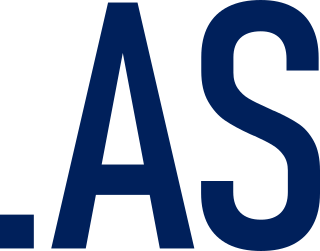Related Research Articles
The Domain Name System (DNS) is a hierarchical and distributed name service that provides a naming system for computers, services, and other resources on the Internet or other Internet Protocol (IP) networks. It associates various information with domain names assigned to each of the associated entities. Most prominently, it translates readily memorized domain names to the numerical IP addresses needed for locating and identifying computer services and devices with the underlying network protocols. The Domain Name System has been an essential component of the functionality of the Internet since 1985.

In the Internet, a domain name is a string that identifies a realm of administrative autonomy, authority or control. Domain names are often used to identify services provided through the Internet, such as websites, email services and more. Domain names are used in various networking contexts and for application-specific naming and addressing purposes. In general, a domain name identifies a network domain or an Internet Protocol (IP) resource, such as a personal computer used to access the Internet, or a server computer.
The domain com is a top-level domain (TLD) in the Domain Name System (DNS) of the Internet. Created in the first group of Internet domains at the beginning of 1985, its name is derived from the word commercial, indicating its original intended purpose for subdomains registered by commercial organizations. Later, the domain opened for general purposes.

The domain name .org is a generic top-level domain (gTLD) of the Domain Name System (DNS) used on the Internet. The name is truncated from 'organization'. It was one of the original domains established in 1985, and has been operated by the Public Interest Registry since 2003. The domain was originally "intended as the miscellaneous TLD for organizations that didn't fit anywhere else". It is commonly used by non-profit organizations, open-source projects, and communities, but is an open domain that can be used by anyone. The number of registered domains in .org has increased from fewer than one million in the 1990s, to ten million in 2012, and held steady between ten and eleven million since then.

Verisign, Inc. is an American company based in Reston, Virginia, that operates a diverse array of network infrastructure, including two of the Internet's thirteen root nameservers, the authoritative registry for the .com, .net, and .name generic top-level domains and the .cc country-code top-level domains, and the back-end systems for the .jobs and .edu sponsored top-level domains.
The Domain Name System Security Extensions (DNSSEC) is a suite of extension specifications by the Internet Engineering Task Force (IETF) for securing data exchanged in the Domain Name System (DNS) in Internet Protocol (IP) networks. The protocol provides cryptographic authentication of data, authenticated denial of existence, and data integrity, but not availability or confidentiality.
Domain hijacking or domain theft is the act of changing the registration of a domain name without the permission of its original registrant, or by abuse of privileges on domain hosting and registrar software systems.

The domain name gov is a sponsored top-level domain (sTLD) in the Domain Name System of the Internet. The name is derived from the word government, indicating its restricted use by government entities. The TLD is administered by the Cybersecurity and Infrastructure Security Agency (CISA), a component of the United States Department of Homeland Security.
A domain name registrar is a company, person, or office that manages the reservation of Internet domain names.
.name is a generic top-level domain (gTLD) in the Domain Name System of the Internet. It is intended for use by individuals for representation of their personal name, nicknames, screen names, pseudonyms, or other types of identification labels.

Domain name speculation, popular as domain investing, domain flipping or domaining in professional jargon, is the practice of identifying and registering or acquiring generic Internet domain names as an investment with the intent of selling them later for a profit.

The domain name net is a generic top-level domain (gTLD) used in the Domain Name System of the Internet. The name is derived from the word network, indicating it was originally intended for organizations involved in networking technologies, such as Internet service providers and other infrastructure companies. However, there are no official restrictions and the domain is now a general-purpose namespace.
The Extensible Provisioning Protocol (EPP) is a flexible protocol designed for allocating objects within registries over the Internet. The motivation for the creation of EPP was to create a robust and flexible protocol that could provide communication between domain name registries and domain name registrars. These transactions are required whenever a domain name is registered or renewed, thereby also preventing domain hijacking. Prior to its introduction, registries had no uniform approach, and many different proprietary interfaces existed. While its use for domain names was the initial driver, the protocol is designed to be usable for any kind of ordering and fulfilment system.

.as is the Internet country code top-level domain (ccTLD) for American Samoa. It is administered by AS Domain Registry. Island Networks, which provides registry services for .gg and .je, is also responsible for the technical operations of .as.

.na is the Internet country code top-level domain (ccTLD) for Namibia corresponding to the two letter code from the ISO-3166 standard.
WHOIS is a query and response protocol that is used for querying databases that store an Internet resource's registered users or assignees. These resources include domain names, IP address blocks and autonomous systems, but it is also used for a wider range of other information. The protocol stores and delivers database content in a human-readable format. The current iteration of the WHOIS protocol was drafted by the Internet Society, and is documented in RFC 3912.
An Auth-Code, also known as an EPP code, authorization code, transfer code, or Auth-Info Code, is a generated passcode required to transfer an Internet domain name between domain registrars; the code is intended to indicate that the domain name owner has authorized the transfer.
Domain registration is the process of acquiring a domain name from a domain name registrar.

Public Interest Registry is a not-for-profit based in Reston, Virginia, created by the Internet Society in 2002 to manage the .ORG top-level domain. It took over operation of .ORG in January 2003 and launched the .NGO and .ONG top-level domains in March 2015.
The Registration Data Access Protocol (RDAP) is a computer network communications protocol standardized by a working group at the Internet Engineering Task Force in 2015, after experimental developments and thorough discussions. It is a successor to the WHOIS protocol, used to look up relevant registration data from such Internet resources as domain names, IP addresses, and autonomous system numbers.
References
- ↑ RFC 2832 - NSI Registry Registrar Protocol (RRP) Version 1.1.0
- ↑ RFC 3632 - VeriSign Registry Registrar Protocol (RRP) Version 2.0.0
- ↑ "Does Your Domain Have a Registry Lock? – Krebs on Security". 24 January 2020. Retrieved 2022-06-16.
- ↑ "What is Domain Registrar Lock? (For new customers transferring to Z.com) – Customer Success Team Advice and Answers" . Retrieved 2024-11-27.
- ↑ Staff, NameSilo. "Domain Locks: Registrar Lock vs. Registry Lock | NameSilo". Domain Locks: Registrar Lock vs. Registry Lock | NameSilo. Retrieved 2024-11-26.
- ↑ "Prevent Domain Hijacking With Verisign Registry Lock Service - Verisign". www.verisign.com. Retrieved 2024-11-26.
- ↑ "Registry Lock - Lock your domain name against hacking attempts". Nameshield. Retrieved 2024-11-25.